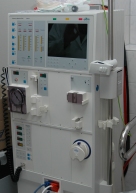Dialysis
Dialysis is a treatment recommended by doctors for patients diagnosed with stage 4 or stage 5 chronic kidney disease (CKD) to substitute for their severe loss of kidney functions. At this point, the build up of waste in the blood has reached the point where it can no longer go without treatment and requires a dialysis plan be made by the doctor and the patient. The two main types of dialysis are hemodialysis and peritoneal dialysis, both with the purpose of removing excess waste in the blood.
Hemodialysis
Hemodialysis involves the use of a hemodialysis machine and a dialyzer (right) that acts as an artificial kidney and filters the blood outside of the body, removing the built up waste left in by the failing kidneys. In order to cycle the blood out of and back into the body, a “vascular access” site is needed and usually made on the arm or leg. The creation of the access site will be done by one of two different ways: an arteriovenous (AV) graft, or an arteriovenous (AV) fistula. To install an AV graft, a vein and artery is connected to each other in the arm by a plastic tube (graft). As for an AV fistula, a vein and artery is directly connected together in the arm to make one larger vessel. After the access site is healed, the patient can then undergo dialysis, starting with the insertion of two needles in the access site to begin the filtration of blood out and through the dialyzer and back into the body with reduced waste. Depending on the patient’s severity of their disease and schedule, they usually require dialysis three times a week, ranging from 2-4 hours each session. Patients go to a hemodialysis unit where the treatment is performed, their access site is cleaned, and dialysis is started. During the process, the patient is confined to their dialysis station but can still perform activities such as reading or watching television and other things.

Hemodialysis Machine & Dialyzer

Fistula vs. Graft
Peritoneal Dialysis
During peritoneal dialysis, a specific fluid, depending on what waste needs to be filtered out, called dialysate is used to draw out the waste in the abdominal cavity underneath the peritoneal membrane. After a surgery is performed to insert a catheter into the abdomen, the patients can administer the dialysate themselves wherever they please. About 4-5 times a day, a certain amount, based on their body weight, is drained into the abdominal cavity and allowed to draw the waste out of the blood, then drained back out through the catheter again. Although this makes the patients responsible for their own dialysis, it allows for more independence.
Each technique has both advantages and disadvantages. Hemodialysis requires less work by the patient and less sessions but involves a stricter diet and schedule. Peritoneal dialysis is more independent and has flexible scheduling but requires more work and responsibility and increases the risk of infection. Both are effective and are ultimately up to the patient to decide which they prefer. Dialysis may seem like a major inconvenience in the patient’s daily routine but is necessary for their health considering that the only other option is a kidney transplant, which is difficult to obtain. However, patients who undergo dialysis are still able to hold a normal and manageable lifestyle.

Excellent video very helpful!
The tab for dialysis is not capitalized and is in italics when none of the other tabs are.
That’s what happens when you are on that particular tab…the tab you are on becomes italicized and lower case.
Oh ha ha wow I’m sorry.